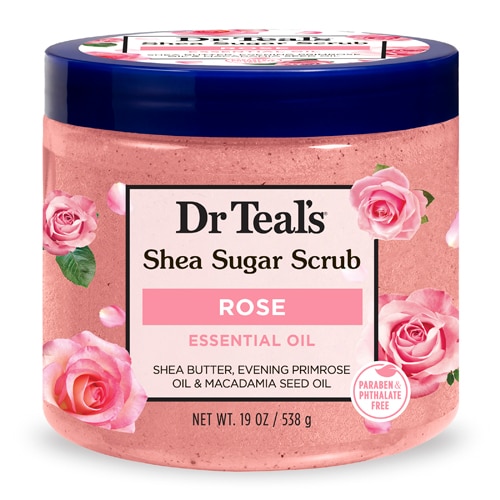[vc_row][vc_column][vc_column_text]
Exfoliation is a technique that helps remove dead cells from the skin’s surface, leaving skin clearer, softer and – for many – visibly glowing. Regular exfoliation is a great way to prevent clogged pores and the formation of blemishes and acne, which often occur due to buildup of dead skin cells and debris, like sebum, oil and keratin.
Of course, dead skin cells naturally shed to an extent; however, at times they can linger on the skin’s surface, in which case manual exfoliation can help get the job done.

Different methods of exfoliation
There are two types of exfoliants: physical and chemical. Physical exfoliants, such as
scrubs and
cleansers, remove dead skin cells and are abrasive, gritty or jelly-like in texture. They’re generally safer to use than chemical peels and are less likely to cause adverse reactions and side effects.
Physical exfoliants contain granules, sugar, seeds or nutshells to effectively remove buildup and unclog pores. They’re the easiest way to fix a “dull” complexion, which often happens when you’re not exfoliating enough.
You also can use exfoliation devices, including facial massagers, loofahs and brushes, to boost circulation and blood flow, giving skin a nice, natural flush and freshness and a healthy glow.
What happens if you exfoliate too much
Exfoliating excessively can leave skin looking and feeling raw, and if you continue exfoliating too much, these side effects can worsen, leading to redness, cracks, flaking, oozing and crusting as your skin tries to heal itself.
“Excessive physical exfoliation can result in significant sloughing of the superficial layers of skin,” says board-certified dermatologist and founder of
AmberNoon,
Erum N. Ilyas, MD, MBE, FAAD. If skin is left in this “raw” state, it may heal with hyperpigmentation.
“I once had a patient that used a Clarisonic so aggressively that she had circular patches of hyperpigmentation afterward,” Ilyas says.
If you have sensitive skin, you may experience a stinging or burning sensation with application of exfoliating products (at which point you should stop and switch to a formula for sensitive skin). If you have normal skin, you likely won’t experience irritation with appropriate exfoliation. But overdoing it can lead to the issues noted above – and just moisturizing afterward may not be enough to fix them.
How to exfoliate without overdoing it
First, evaluate your exfoliating products. If you’re using a chemical peel and experience issues, switch to a physical exfoliant. Chemical exfoliants can contain strong ingredients that may irritate skin and lead to pigmentation issues.
“Chemical exfoliants use ingredients like alpha hydroxy acids, beta hydroxy acids and enzymes to dissolve fats or lipids in the superficial layers of skin,” Ilyas notes. The exfoliants help cells to shed, leaving behind byproducts, such as keratin, sebum and oil.
If your skin tolerates chemical exfoliating, it can be done daily. For physical exfoliation, frequency depends on your skin’s sensitivity level. Those with oily skin may be able to exfoliate two or three times per week without issues. For people with less oily skin, exfoliation once weekly may be sufficient.
Remember, frequency not only depends on skin type and sensitivity, but also on underlying skin conditions, humidity levels and season, your overall skincare routine and, lastly, age.
“In general, thick, oily, non-rosacea prone skin can likely tolerate daily exfoliation, while the opposite end of the spectrum may have to stick to once weekly or less,” says Ilyas.
For acne-prone skin, it’s a misconception that excessively exfoliating to unclog pores will accelerate skin turnover when breakouts are present.
“Over exfoliating has been linked to worsening acne and breakouts, making it more difficult to heal, so you must find a balance between exfoliating and hydrating to allow skin to heal without producing excess sebum as a means to compensate for the excess dryness,” Ilyas explains.
How to choose an exfoliant
Start by looking at labels. Read the ingredients list and look for key ingredients such as kelp and seaweed, clay, apricot and other antioxidant-rich extracts of fruit (like apricot and grapefruit) and a soothing addition, such as rose (in the form of rosehip oil extract or rosewater).
“Kelp has proven anti-inflammatory benefits and clay can help absorb excess oil or sebum in the skin,” says Ilyas.
The benefits of seaweed and clay in a
facial scrub and exfoliant are especially helpful for those with acne-prone skin, as they offer balanced benefits including reducing inflammation and absorbing excess oil.
Products with fruit extracts, like apricot scrubs, typically have a gritty texture that helps slough away dead skin cells while also brightening and smoothing skin. Apricot scrubs additionally contain fatty acids to hydrate as you exfoliate, helping to combat dryness.
Rose offers several healing properties and is helpful for both preventing acne and calming skin to avoid irritation with use.
“Rose can come from rose petal extract, rosehip oil extracted from the seeds, or rosewater made from a byproduct of creating rose oil and has been used for centuries for its fragrance and medicinal qualities,” Ilyas says. “Research supports its anti-inflammatory, antimicrobial and acne-fighting properties, in particular,” she adds. A facial
cleanser with exfoliant properties and rose is a great option for healthy skin maintenance and safe and effective removal of dead skin cells.
Help for when you’ve over-exfoliated
If skin becomes raw from over-exfoliation, it’s a good idea to apply a layer of
petroleum jelly while it heals; but of course, it’s best to avoid any irritation to begin with! Consult with an esthetician or dermatologist for personalized advice on the best exfoliation practices and products for you.[/vc_column_text][/vc_column][/vc_row][vc_row][vc_column][vc_text_separator title="Exfoliants to Try " border_width="2"][vc_row_inner equal_height="yes" content_placement="middle" gap="35"][vc_column_inner width="1/3"][vc_single_image image="161768" img_size="full" alignment="center" onclick="custom_link" img_link_target="_blank" css=".vc_custom_1660256488392{padding-right: 7% !important;padding-left: 7% !important;}" link="https://www.vitacost.com/spa-sciences-mio-diamond-microdermabrasion-pore-extraction-skin-resurfacing-system-mint"][/vc_column_inner][vc_column_inner width="1/3"][vc_single_image image="161766" img_size="full" alignment="center" onclick="custom_link" img_link_target="_blank" css=".vc_custom_1660256504303{padding-right: 7% !important;padding-left: 7% !important;}" link="https://www.vitacost.com/dr-teals-shea-sugar-scrub-rose-essential-oil"][/vc_column_inner][vc_column_inner width="1/3"][vc_single_image image="161767" img_size="full" alignment="center" onclick="custom_link" img_link_target="_blank" css=".vc_custom_1660256526045{padding-right: 7% !important;padding-left: 7% !important;}" link="https://www.vitacost.com/reviva-labs-light-skin-peel-mild-exfoliant"][/vc_column_inner][/vc_row_inner][/vc_column][/vc_row]




